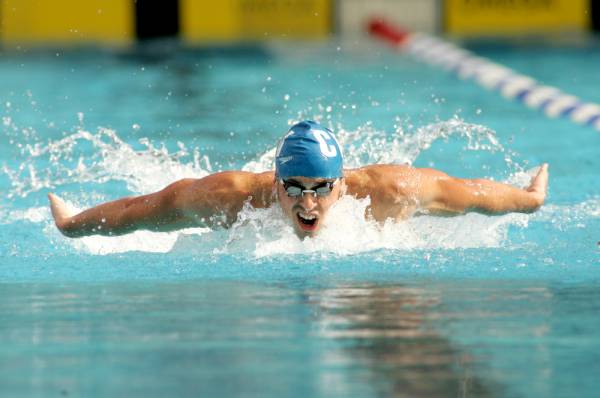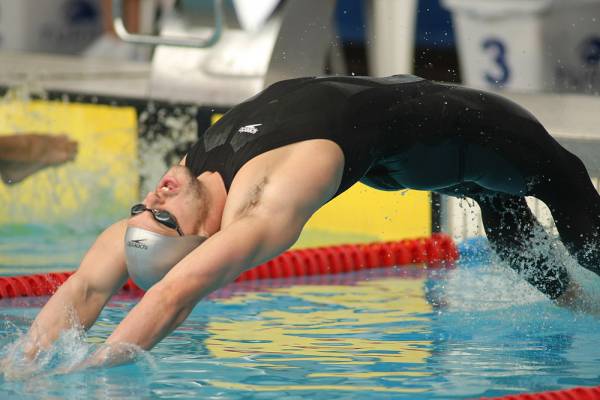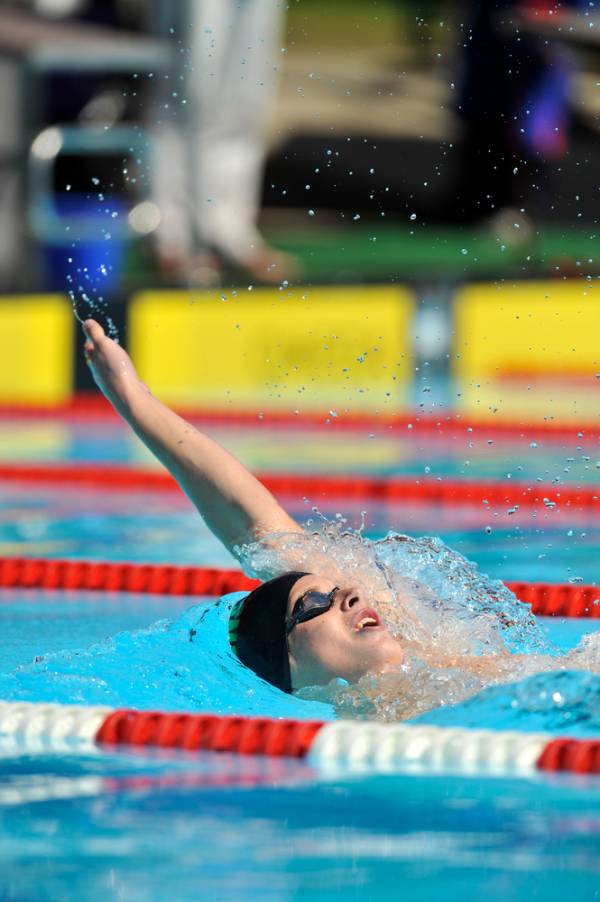With less than a week until the opening ceremony for the Games of the XXX Olympiad, it is hard to contain my excitement of what may happen in my number one sport – swimming – this year. This first of the swimming action is set to happen July 28, with four Olympic Gold medals disputed on the first day. Thirty-four events (seventeen male and seventeen female) are scheduled in swimming at the London Olympics.
Historic Perspective
London is the first city to host the modern Olympic games for a third time, after hosting in 1908 and 1948. London will host twenty-six sports and thirty-nine disciplines, of which swimming is undoubtedly one of the most popular. It is a discipline that has been featured at every modern Summer Olympic Games (starting in 1896), and has been open to women since 1912.
The sport of swimming has evolved significantly since its inception. This year, swimming events will take place at a state of the art facility especially constructed for the Olympics at the London Aquatics Center. The complex boasts two 50m pools and one 25m diving pool. But facilities like this haven’t always been the case for swimming. At the first three Olympics (1896, 1900 and 1904), swimming was held in open water.
Other interesting facts about the history of swimming in the Olympics:
- The 1904 Olympics, held in St Louis, Missouri, were the only ones where swimming was contested in yards instead of meters.
- At the London 1908 Olympics, swimming was contested in a custom built 100m pool placed in the middle of the track and field oval.
- The 1912 Stockholm Olympics featured swimming in a 100m course in Stockholm Harbor, with the inclusion of two events for women for the first time in Olympic history.
- The emergence of the standard 50m pool (commonly referred to as Olympic size) didn’t happen until the 1924 Paris Olympics.
- Diving blocks did not make an appearance until the 1936 Berlin Olympics.
And not just the venues, but the pools themselves have improved over the years. The design of the standard 50m pool has improved significantly, affording swimmers to swim faster. Engineering feats have allowed significant drag coefficient reduction by manipulation of pool depth, elimination of waves and currents, increased lane width, energy absorbing lane lines and gutters, and the use of other innovative hydraulic, acoustic, and illumination features. The diving block has also undergone significant changes over the years, allowing swimmers to have more effective reaction times and powerful dives.
 The events offered have also changed significantly over the years. For example, butterfly events did not appear until the 1956 Melbourne Olympics. Prior to that butterfly was recognized as part of the breaststroke. The 1968 Mexico City Olympics saw the introduction of a distance event for women, the 800m. Up until then women were considered to be too delicate to swim such long races. Today both the men’s and women’s schedules include seventeen events, sixteen of which are the same. The one difference is still in the distance event, where men swim the 1500m while women only swim 800m. Interestingly, at the 2008 Beijing Olympics the first marathon swimming event was introduced, 10km, and offered to both men and women.
The events offered have also changed significantly over the years. For example, butterfly events did not appear until the 1956 Melbourne Olympics. Prior to that butterfly was recognized as part of the breaststroke. The 1968 Mexico City Olympics saw the introduction of a distance event for women, the 800m. Up until then women were considered to be too delicate to swim such long races. Today both the men’s and women’s schedules include seventeen events, sixteen of which are the same. The one difference is still in the distance event, where men swim the 1500m while women only swim 800m. Interestingly, at the 2008 Beijing Olympics the first marathon swimming event was introduced, 10km, and offered to both men and women.
Pools and event distance/number/type aren’t the only things that evolved in the sport. One of the most notable (and possibly controversial) evolutions has been in swimwear. Full body suits were worn by men up until the 1940s. These were poorly designed and significantly increased resistance. Over the years we have seen changes in design and fabric – the late 80s saw the popularity of the “paper” swimsuit, and the 90s saw the reintroduction of the full body suit, this time with a much better design than the pre-1940s counterpart.
The body suit continued to evolve, offering a myriad of combination possibilities to suit swimmers/stroke preferences. The Speedo LZR was possibly the first generation of state of the art body suits, and several other companies invested heavily in creating the fastest suit possible. The apex of swimsuit design came with the introduction of the seamless, non-fabric suits (the most notable being the Jaked J01 and the Arena X-Glide) that not only reduced drag, but significantly improved swimmer’s buoyancy. Practically every record in the books was tackled in 2009 by swimmers wearing one of these suits. But through intense lobbying by swimmers who felt these suits provided an unfair advantage (it still baffles me to this day how this was unfair, considering the suits were commercially available to ANY swimmer and being openly worn in competition) the suits were eventually banned and very strict regulations on what is or is not allowed in competition were put in place. These regulations were enacted and are upheld by the Federation Internationale de Natation (FINA).
 Suit engineering is still a hot topic in swimming, with new state of the art suits being developed every year, but all while meeting the requirements set forth by FINA. At the London Olympics no full body suits will be allowed. For both men and women the suit must be one hundred percent fabric. Women may wear a suit that covers from neck to knees, provided the shoulders are not covered, and the suit does not use a zipper for closure. Men are limited to a maximum of coverage from waist to knee. In no circumstances may a swimmer, male or female, wear more than one suit while racing. Nowadays several companies have also started playing around with goggle and cap design. For most, however, the advantage is yet to be determined. Interestingly, goggles were first allowed at the 1976 Montreal Olympics.
Suit engineering is still a hot topic in swimming, with new state of the art suits being developed every year, but all while meeting the requirements set forth by FINA. At the London Olympics no full body suits will be allowed. For both men and women the suit must be one hundred percent fabric. Women may wear a suit that covers from neck to knees, provided the shoulders are not covered, and the suit does not use a zipper for closure. Men are limited to a maximum of coverage from waist to knee. In no circumstances may a swimmer, male or female, wear more than one suit while racing. Nowadays several companies have also started playing around with goggle and cap design. For most, however, the advantage is yet to be determined. Interestingly, goggles were first allowed at the 1976 Montreal Olympics.
2012 – Here We Are, In London
So what to expect in London? One hundred and sixty-six nations will compete in swimming in London. Each country is allowed up to two qualified swimmers per individual event and one relay team. Each participating country is allowed a maximum of fifty-two swimmers (twenty-six male and twenty-six female). In London, China will bring the largest contingent with fifty-one swimmers, followed by the United States with forty-nine.
But how did these swimmers get to be in London? Ah, the qualification process I am all too familiar with. Although each country has authority on how to select the swimmers who represent them, the International Olympic Committee (IOC) establishes a standard that must be met in order for a swimmer to be eligible to compete at the Olympic Games. As with previous Olympics, FINA published two sets of standards for London: the “Olympic Qualifying Standard” and an “Olympic Invitation Standard.” Each country may enter up to two swimmers per event, provided both swimmers meet the qualifying time. A country may enter one swimmer per event who meets the invitation standard. Any swimmer who meets the qualifying time will be entered in the event for the Games; a swimmer meeting the invitation standard will be eligible for entry, and their entry will be allotted/filled in by ranking. A country that does not receive an allocation spot, but has at least one swimmer who meets a qualifying standard may enter the swimmer with the highest ranking. If a country has no swimmers meeting either qualifying standard, it may enter one male and one female in total. We have seen this happen and made popular at games like the 2000 Sydney Olympics, which crowned minor celebrities from Equatorial Guinea, Eric “the Eel” and Paula Barila. The latter set the slowest time in Olympic history for the 50m freestyle.
Who Will the 34 Olympic Swimming Champions Be?
 I have high expectations for the London Olympics. Unlike prior Olympics in which I failed to qualify, this time around I am really excited to see the action unfold. Although I don’t think the excitement as a whole will be as climactic as Michael Phelps claiming the most Gold medals in Olympic history in Beijing, the excitement comes from having multiple favorites for most events. Watching the fierce battles in the pool will be nail biting and a true test to the swimmers’ preparation for this major event.
I have high expectations for the London Olympics. Unlike prior Olympics in which I failed to qualify, this time around I am really excited to see the action unfold. Although I don’t think the excitement as a whole will be as climactic as Michael Phelps claiming the most Gold medals in Olympic history in Beijing, the excitement comes from having multiple favorites for most events. Watching the fierce battles in the pool will be nail biting and a true test to the swimmers’ preparation for this major event.
There are many, many mention worthy swimmers, and I could probably make a fairly large list. I am personally looking forward to seeing the battles between Michael Phelps and Ryan Lochte in several events, Missy Franklin’s (who has been coined as the female Michael Phelps) Olympic debut, how dominant will the European female sprinters be (okay, I am European, and I am a sprinter so maybe I may have a little bias), but probably, no, definitely, the event I am most looking forward to is the women’s 100m Breaststroke that features one of my former teammates, Breeja Larson, who qualified first at the U.S. Olympic trials in a major upset to the overwhelming favorite Rebecca Soni (who qualified in second and will also swim the event) and world record holder Jessica Hardy.
For more information visit the London Olympics website or the NBC Olympics website.
Photos courtesy of Shutterstock.






